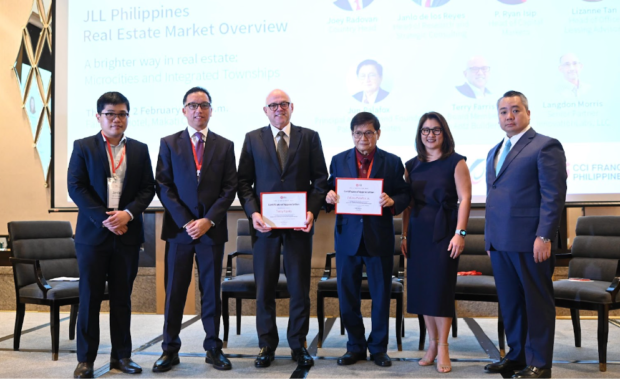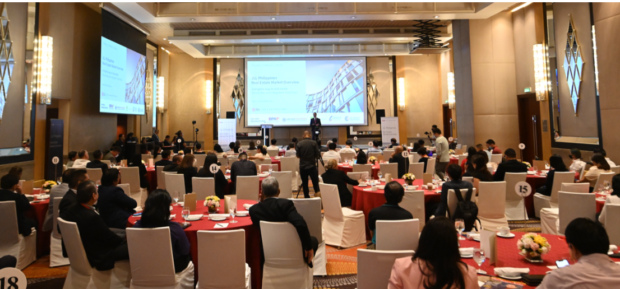JLL Philippines holds first market overview for 2023, delves into microcities and integrated townships
In JLL Philippines’ real estate market overview, “A Brighter Way in Real Estate: Microcities and Integrated Townships”, the firm presented a recap of 2022’s industry landscape, an outlook for 2023, as well as zoomed in on the cross-sectoral impact of microcities amidst the challenging global economic conditions impacting our local market.

[L-R] Janlo de los Reyes, Head of Research and Strategic Consulting, JLL Philippines; Joey Radovan, Country Head, JLL Philippines; Terry Farris, Board Member, Green Antz Builders; Principal Architect and Urban Planner, Architect Felino “Jun” Palafox Jr., Palafox Associates; Lizanne Tan, Head of Office Leasing Advisory, JLL Philippines; P. Ryan Isip, Head of Capital Markets, JLL Philippines

JLL Philippines’ Real Estate Market Overview, February 2023
“The new year gives us another opportunity to better leverage JLL’s global experience and adopt these learnings in our local market. This helps us create positive impact amidst challenging global economic conditions,” said Joey Radovan, JLL Philippines’ Country Head. “We are happy to start the year not just with an update on the office, hospitality, retail, and residential sectors, but also by inviting an expert panel of speakers to bring their views on how cities are being impacted by changes in technology, sustainable design and waste management, amongst other broad themes and align with our commercial real estate expertise.”
Lizanne Tan, JLL Philippines’ Head of Office Leasing Advisory, provided an overview of the top global real estate trends for 2023. “We see top 10 real estate trends for 2023, but we see three key elements that will impact the future of work in the country: hybrid reality, connected communities, and innovation clusters,” she said.
Ryan Isip, JLL Philippines’ Head of Capital Markets, listed five key trends in the real estate market. “On a global perspective, Asia outpaces Europe in capital raise. As for what can be observed here, the Japanese are currently the most active investors,” said Isip. “Additionally, Mainland Chinese spurring tourism and the Asian Association for Investors in Non-Listed Real Estate Vehicles (ANREV) investment intention and allocation are also seen to impact the market. “We’re seeing increased transactions in hospitality due to revenge travel,” he added.
Office leasing volumes surpass 2021 levels
“The office leasing market has been relatively stable,” said Janlo de los Reyes, JLL Philippines’ Head of Research and Strategic Consulting.
Gross leasing volumes in Metro Manila totals 669,000 sqm in 2022, which is 67% higher than the 2021 total of 401,000 sqm. Meanwhile, leasing activities in Metro Cebu are sustained despite headwinds, with 43,664 sqm in the fourth quarter from 41,853 sqm in the third quarter of 2022.
As of the fourth quarter of 2022, corporates (51.5%) outpaced offshoring & outsourcing (O&O) demand (44.8%) in Metro Manila, with media (31%) and banking (24%) occupiers accounting for most of the corporate occupiers. From a year-to-date perspective, however, O&Os still led transaction volumes (65.2%, versus corporate occupiers at 28.6%). The sudden shift in the final quarter may be attributed to occupiers’ holding off decisions on transfers relative to incentives in December 2022. In Metro Cebu, however, O&O continued to lead transactions (87.0%), followed by flexible workspace (13.0%).
Rightsizing among occupiers continued, with 129,949 sqm of released space in Metro Manila by the fourth quarter of 2022. In relation to this, Metro Manila vacancy rose behind weaker leasing demand and new supply. In Metro Cebu, however, vacancy continued to decline to 17.8%.
Rents in Metro Manila also remained soft, and the gap between headline and transacted rents continue to narrow, closing at 4.3% in the fourth quarter (from 5.9% in the third quarter) or 2022.
Holiday surge drove retail store openings
The retail sector saw more store openings than closings in the last quarter of 2022, with move-ins from several foreign brands. The food and beverage (F&B) retail category continues to lead both move-ins and move-outs. The last quarter also saw many local brands across different retail categories move-out.
Vacancy levels declined despite new supply, and rents rose as leasing activities accelerate.
Minimal expansion on residential vacancy
In the residential rector, there is minimal expansion on residential vacancy for both midscale and upscale segments. Price hikes continued for both midscale and upscale segments, although less steep than previous levels.
Seasonal demand lifted occupancy in hospitality
There is a significant activity in the hospitality sector as international tourists exceeded the 2022 target of expected arrivals (1.7 million expected vs. 2.65 million actual). The fourth quarter of 2022 saw 88.3% occupancy of hotels in Metro Manila, higher than the previous quarter (77.1%). Leisure oriented hotels registered high occupancy due to holiday demand. Room rates continued to increase (PHP7,362/room/night) as demand recovers, albeit still lower than pre-pandemic levels (PHP9,100/room/night).

JLL Philippines Real Estate Market Overview
Microcities and Integrated Townships
JLL’s panel of experts were joined by Langdon Morris, Senior Partner at InnovationLabs LLC; Terry Farris, Board Member of Green Antz Builders; and renowned architect and Urban Planner, Architect Felino “Jun” Palafox Jr.
“Everything is changing, and globally we are experiencing shifts in factors that affect the overall performance of cities, and countries,” said Morris. He identified seven key themes experiencing shifts, and these are climate, energy, technology, demographics, geopolitics, economy, and data.
Farris presented a sustainability solutions-driven presentation with Green Antz, a plastic recycling company with output products that can be used for construction. “The Philippines contributes 30% of plastic waste in the ocean and is one of the countries that accepts plastic imports. However, there is a disconnect here because we lack facilities for plastic recycling.”
Finally, Palafox shared insights on improving urban planning through increased connectivity. “The Philippines needs roughly 400 airports. The proposed New Manila International Airport can help ease traffic and increase accessibility and connectivity,” he said.
Palafox shares that tourism is essential for investment, and that airports are the calling card of a country. “You must first be a satisfied tourist before you become an investor,” he adds.
Economic headwinds to weigh down on the market
Challenging economic conditions are expected to subdue performance and activities in the real estate market. Current statistics show increasing interest rates, increasing inflation rate, and weaker peso to dollar value affecting the economy.
There is also supply pressure from incoming stock across sectors in Metro Manila and Metro Cebu. The Metro Manila office sector is expecting around 1.2 million sqm of incoming stock until 2025, while Metro Cebu may have an additional 194,700 sqm within the same time frame. Additionally, Metro Manila retail is expecting 470,000 sqm of incoming stock, residential with 86,500 units, and hospitality with 6,400 rooms.
Despite this, de los Reyes said that there are fundamental market drivers buoying the real estate industry. “The sustained growth of IT-BPM, improving return-to-office, and the recovery of tourism are seen as ‘floaters’ through rough currents,” said de los Reyes.
ADVT.
Read more stories here:
Romantic treats, fabulous feasts for the Month of Love
Vista Mall allows you to create beautiful memories this Valentines Day